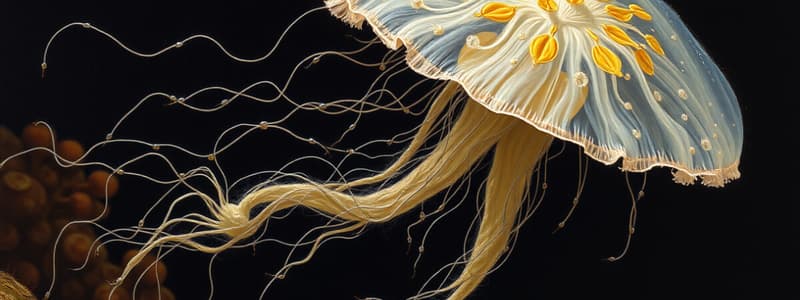Podcast
Questions and Answers
What is the primary function of the contractile vacuole in some protozoa?
What is the primary function of the contractile vacuole in some protozoa?
- Ingesting solid particles
- Generating energy through respiration
- Facilitating movement
- Osmoregulation (correct)
Which type of feeding process involves engulfing solid particles in protozoa?
Which type of feeding process involves engulfing solid particles in protozoa?
- Pinocytosis
- Absorption
- Autotrophy
- Phagocytosis (correct)
What is the structure that maintains the shape of certain protozoa called?
What is the structure that maintains the shape of certain protozoa called?
- Endoplasm
- Pellicle (correct)
- Ectoplasm
- Cytosome
How do many protozoa primarily reproduce?
How do many protozoa primarily reproduce?
Which of the following describes the type of nutrition characteristic of all protozoa?
Which of the following describes the type of nutrition characteristic of all protozoa?
What characteristic of cysts allows them to survive in the external environment?
What characteristic of cysts allows them to survive in the external environment?
What mode of transmission does not involve indirect contact with a host?
What mode of transmission does not involve indirect contact with a host?
Where do the oocysts of Plasmodium develop?
Where do the oocysts of Plasmodium develop?
Which organisms are transmitted via faecal-oral transmission?
Which organisms are transmitted via faecal-oral transmission?
Which of the following methods of transmission involves direct intimate body contact?
Which of the following methods of transmission involves direct intimate body contact?
What is one way protozoa can be transmitted between hosts?
What is one way protozoa can be transmitted between hosts?
Which phylum of Protozoa is characterized by having a definite body shape?
Which phylum of Protozoa is characterized by having a definite body shape?
What type of transmission involves a predator consuming a prey animal that harbors zoites?
What type of transmission involves a predator consuming a prey animal that harbors zoites?
Which of the following examples involves a blood-sucking arthropod transmitting a protozoan to humans?
Which of the following examples involves a blood-sucking arthropod transmitting a protozoan to humans?
Sarcodines are characterized by which of the following features?
Sarcodines are characterized by which of the following features?
Flashcards are hidden until you start studying
Study Notes
Protozoa Structure
- Pellicle provides rigidity and maintains a distinctive shape in some protozoa.
- Cytoplasm is divided into ectoplasm (outer, transparent) and endoplasm (inner, organelle-containing).
- Pseudopodia are used for movement and food capture, especially noted in amoebas.
- Some protozoa have a cytosome for fluid and particle ingestion.
- Contractile vacuoles in organisms like Naegleria regulate water balance.
- Apicomplexa lack external locomotion organelles but employ subpellicular microtubules for movement.
- Distinct structures include Golgi apparatus, mitochondria, lysosomes, and food vacuoles.
Nutrition in Protozoa
- All protozoa are holozoic, requiring organic matter either in solution or particulate form.
- Amebas use temporary mouths to engulf food, digest within food vacuoles, and eject waste.
- Permanent mouths, cytosomes or micropores, allow for continuous food intake.
- Pinocytosis involves drawing in fluid nutrient material via openings in the cell wall.
Modes of Nutrition
- Autotrophic: Photosynthesis occurs during the day.
- Heterotrophic: Nutrient absorption occurs predominantly at night.
- Phagocytosis and pinocytosis are key methods of nutrient uptake.
Reproduction
- Protozoa reproduce asexually and sexually; binary fission is the most common asexual method.
- Cysts released in feces can survive external environments for days up to a year.
- Oocysts, formed via sexual reproduction, are significant in the Apicomplexa group.
Transmission Modes
- Direct transmission: Infections spread through intimate body contact (e.g., Trichomonas spp.).
- Faecal-oral transmission: Involves environmentally resistant cysts ingested from contaminated food or water (e.g., Entamoeba histolytica).
- Vector-borne transmission: Blood-sucking arthropods transfer trophozoites to new hosts (e.g., Trypanosoma brucei).
- Predator-prey transmission: Cysts in prey tissues are ingested by predators, allowing the cycle to continue (e.g., Toxoplasma gondii).
Taxonomic Overview
- Kingdom: Protozoa consists of various phyla such as Sarcodina, Mastigophora, and Apicomplexa.
- Sarcodina encompasses amoeboid forms that may be free-living or parasitic, characterized by pseudopodia.
- Asexual reproduction typically occurs through binary fission, multiple fission, or sporulation.
Important Taxa
- Order Amoebida includes various entozoic amebas found in human or animal intestines, such as Endamoeba and Entamoeba.
- Entamoeba histolytica is notable for causing serious conditions like amebic dysentery.
Life Cycle of Protozoa
- Typical life cycles involve infection through cyst ingestion, trophozoite activity in the intestine, and potential spread to other organs.
- Toxoplasma gondii has a complex life cycle involving both intestinal and extraintestinal stages across different animal hosts.
Malaria and Haemosporidians
- Plasmodium causes malaria, a severe disease affecting humans, with significant mortality in sub-Saharan Africa.
- The species responsible for malaria include P. falciparum, P. vivax, P. ovale, and P. malariae.
Studying That Suits You
Use AI to generate personalized quizzes and flashcards to suit your learning preferences.




